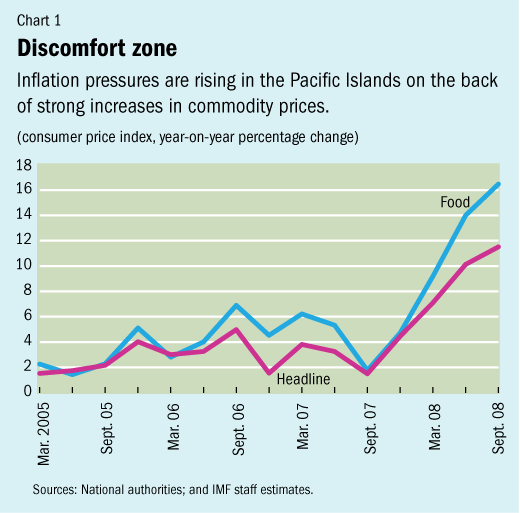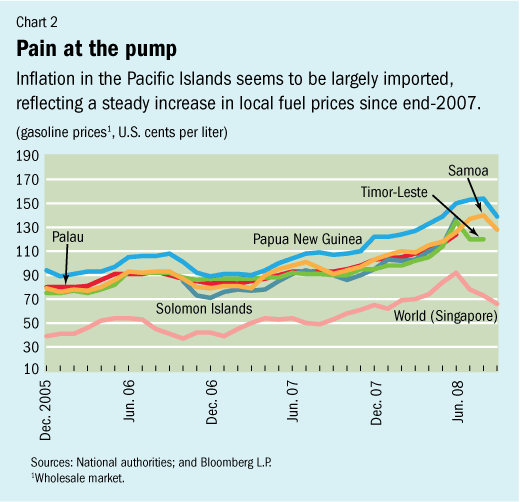PACIFIC ISLAND COUNTRIES

Typical street scene in Santa Ana, El Salvador. (Photo: iStock)
IMF Survey: High Food, Fuel Prices a Threat Where Protection Limited
October 21, 2008
- Pacific Islands particularly vulnerable to swings in commodity prices
- Inflation fuels concern in islands due to large social implications
- High food, fuel prices risk undermining past gains in region's poverty reduction
Inflation has been rising in the Pacific Islands on the back of strong increases in commodity prices.

Dalo harvest in Fiji, where food's big share in consumer price index boosts impact of faster food price inflation (photo: Eric Reed/Victorville Daily Press)
Even though commodity prices have declined from recent peaks, food and fuel prices are still above historical levels and remain a concern in the islands as most have only limited social protection systems.
Headline inflation in the islands has picked up since end-2007 beyond most central banks' comfort zone (see Chart 1). The inflation seems largely imported: Local fuel prices have increased steadily since December 2007. As of September 2008, the pass-through of international gasoline prices to domestic retail prices has been complete for Fiji, Palau, Papua New Guinea, Samoa, the Solomon Islands, and Timor-Leste.

Food price inflation has also increased substantially. The large share of food in the various consumer price index baskets has magnified the impact. Moreover, because of low income levels, much of the food basket includes products that are unprocessed or have little value added, causing a relatively high pass-through of increases in imported food prices. This is due to a low elasticity of demand for these products compared to those with higher value added.
Higher food and fuel costs are a serious issue in the Pacific Islands as pressure is put on household budgets. Rising fuel and food costs put pressure on household budgets. Food-related expenditure is a large share of household spending. The food share in total household spending is on average 50 percent for these islands—about twice as much as in the emerging markets.
Demand pressures
There are also signs of home-grown demand pressures. Credit growth remains high and excess liquidity pervasive in Papua New Guinea and the Solomon Islands. Fiscal policies appear to have turned expansionary in the Solomon Islands, Timor-Leste, and Vanuatu.
Core inflation has already started to trend up. Second-round effects are emerging in Papua New Guinea, the Solomon Islands, Timor-Leste, and Tonga, indicating that inflation has become more entrenched. Higher input costs (of animal feed and fertilizer, in addition to energy) have created upstream pressures on prices. Wage pressures are mounting, notably in Papua New Guinea and the Solomon Islands.
Balance of payments impact
The impact of the higher commodity prices on the Pacific islands' domestic and external balances has been uneven. Most of the islands rely heavily on imports—mostly of food and fuel (see Chart 2)—while their export base remains narrow. As a result, their external balances are vulnerable to commodity price spikes. The Pacific island countries rely almost exclusively on oil-based fuel for their energy needs, limiting the scope for substitution in production and consumption.
Net food and oil importers such as Fiji, Kiribati, Samoa, and Tonga have been hit the hardest and these countries are currently facing wider current account deficits. The Marshall Islands have received an emergency foreign loan to support the domestic energy company, and the government has also contributed to payment for the fuel shipments, which are now secured through end-October.

By contrast, commodity producers such as Papua New Guinea (an exporter of oil, metals, and agricultural products) and Timor-Leste (an oil and gas producer) have benefited from a positive terms of trade shock that so far has strengthened their external and fiscal positions. These countries still have a window of opportunity to convert the windfall gains into benefits for the economy as a whole, but they remain vulnerable to commodity price volatility.
Policy responses to date
Some countries—Palau, Papua New Guinea, Samoa, the Solomon Islands, and Timor-Leste—have passed through the first-round effects of commodity price increases. Import duties and sales tax on rice were eliminated in the Solomon Islands. Import duties on fuel products were recently reduced in Fiji.
In Fiji, some price controls have been used, including delaying scheduled electricity tariff increases. A reduction in sales taxes and import duties was introduced in Timor-Leste. In Timor-Leste the government has also ensured adequate availability of agricultural inputs, including seeds, fertilizer, and diesel to farmers. In the Marshall Islands, the government raised electricity tariffs and introduced tighter controls on the government's use of electricity and fuel; and on import duties, exemptions were granted on basic food staples, including rice, and flour.
Because most of the islands are either dollarized or have a pegged exchange rate regime, the exchange rate has a diminished role in curbing imported inflation. The weakening of both the Australian and New Zealand dollars has generated terms of trade losses for those countries whose exchange rates are pegged to these currencies.
In Papua New Guinea—a country with a more flexible exchange rate—some action has been taken: the central bank has increased the policy rate three times since June, but the real interest rate remains negative
Outlook
The recent decline in commodity prices from record highs in mid-July may provide some respite to inflation. However, inflation is likely to decline only gradually in the Pacific Islands as high transportation costs continue to feed through with a lag.
Commodity exporters still face an opportunity to increase their medium-term growth prospects. Despite recent declines, oil prices remain elevated. In Papua New Guinea and Timor-Leste the oil sector is for the most part foreign owned and little reliant on local inputs.
Most of the linkages to the domestic economy are via the income tax and other revenues to the budget as in Papua New Guinea, or to the petroleum fund as in Timor-Leste. The benefits from high oil prices will depend critically on how revenue windfalls are utilized.
Policy implications
High food and fuel prices pose special challenges to low-income countries such as the Pacific islands. The authorities have to find a fine line between protecting the poor from price increases—especially food—and supporting demand to enhance growth.
Ideally, targeted transfer programs—as part of an integrated social safety net—could reach the poor efficiently. In the absence of effective safety nets, a package of measures building on existing programs such as school feeding programs, cash transfers to the most vulnerable populations, reduced education and health fees, and public transport subsidies could be identified. Instead, ad hoc general increases in public sector wages to compensate workers for higher prices would not be well targeted.
A more effective approach would include targeted demand and supply responses, combined with donor support. The Pacific Islands should continue to allow full pass-through of higher food and fuel prices to domestic prices, while allowing for some time to adjust. Long-term measures, such as in agriculture, rural transport, and other support services, can increase domestic supply and reduce price pressure.
Donor support—preferably grants—would also help limit the harm to real incomes. A more flexible exchange rate regime would also help to cushion inflationary pressures in the commodity exporting countries. In the islands that have full dollarization or a pegged exchange rate regime, the need for fiscal restraint to facilitate the external adjustment and to offset any increase in fuel and food subsidies is clearly heightened.
Comments on this article should be sent to imfsurvey@imf.org







